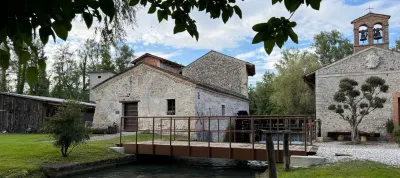General information
RDP Priority
- P6. Social inclusion and local development
RDP Focus Area
- 6B: Local development
RDP Measure
- M07: Basic services & village renewal
Beneficiary type
- Public authority / body
Summary
A small cereal grinding mill, originally part of a famous XVI-century villa, was abandoned some 30 years ago. The Codroipo municipality in the Friuli Venezia Giulia region purchased it in 2013 to restore and use it for cultural and recreational activities for residents and schools. After securing funding from the 2014-2020 Rural Development Programme (RDP), the mill underwent a careful restoration.
Results
- The 140 metre-squared building was fully restored using traditional materials.
- Recreation and cycling itineraries have been launched at the mill.

Promoter
Citta’di Codroipo
Funding
Total budget 330 000 (EUR)
EAFRD: 196 000 (EUR)
Private/own: 134 000 (EUR)
Ressources
Liens
Context
Italy is home to numerous historical treasures, both in its cities and countryside. One example is the abundance of mills near rivers and water sources, particularly in northern regions like Friuli Venezia Giulia. The Bosa mill near Codroipo town has a rich history, dating back to its establishment in February 1524.
This rural complex comprises various buildings from different historical periods, including the miller's house and an icehouse. Originally part of the Villa Manin estate, a renowned 16th-century settlement where Napoleon resided for a brief period, the complex was abandoned around 30 years ago.
In 2013, the Codroipo municipality acquired the property with the intention of restoring it to support cultural and recreational activities for residents and schools. The municipality sought funding for the restoration project through the 2014-2020 RDP in accordance with Regional Law 25/2016.
Objectives
The project objectives were to:
- Restore the mill complex.
- Create a space for recreational and cultural activities.
- Recover a historical rural building as a symbol of local identity.
Activities
Project activities included:
- Strengthening the building structure (consolidating walls, reconstructing the floor slabs, etc.).
- Repairing damaged sections of existing walls and floor coverings.
- Cleaning the mechanical components of the mill.
- Cleaning and landscaping the outdoor areas.
Main results
- The 140 metre-square building was fully restored using traditional materials, such as wooden beams.
- Recreation and cycling itineraries have been launched at the mill, now popular among local residents.
- The landscape around the mill has been improved and educational activities are being planned for local schools.
- As a result of the successful restoration of this mill, the municipality is considering purchasing two other nearby mills that were part of the old Villa Manin estate.
Key lessons
- The value of such projects lies not only in the physical restoration of a historical building but also in their contribution to enhancing the cultural identity of the area.
“Local residents and policymakers were highly satisfied with the project’s outcomes, especially taking into account the previous poor conditions of the mill.”
Ivan Cignola

